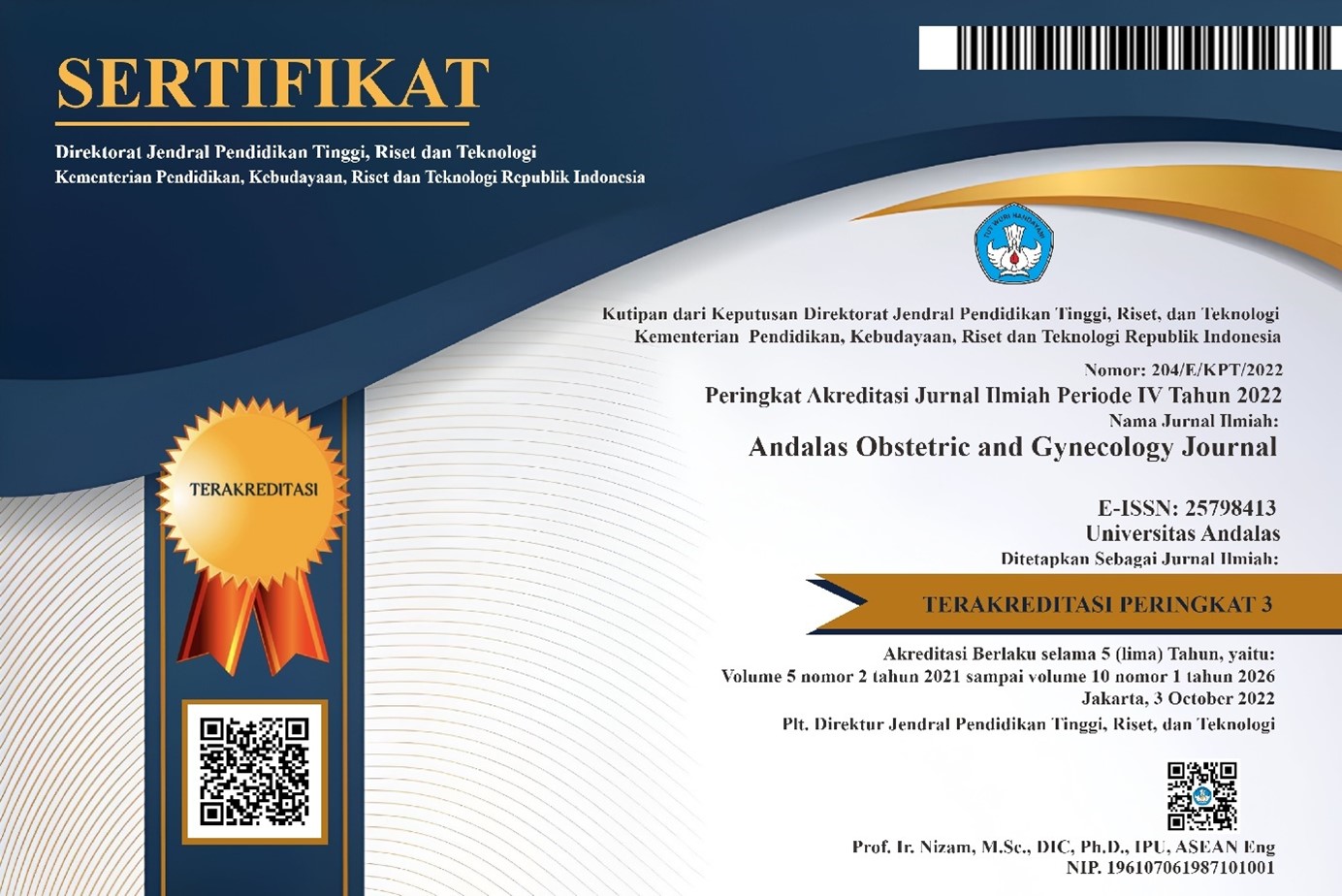Comparison of the Risk Malignancy Index Value of Ovarian Cancer Serosum and Musinosum Type Dr. M. Djamil Padang in 2017
DOI:
https://doi.org/10.25077/aoj.4.1.87-94.2020Abstract
The Risk Malignancy Index (RMI) is one of the simplest assessments that can assist in diagnosing and determining the prognosis of benign and malignant adnexa masses. Epithelial carcinoma is the most common type of about 90% of ovarian cancers. As many as 35-40% of the epithelial type are serous and 6-10% are musinosum.This study aims to compare the picture of RMI value on the incidence of ovarian cancer serosum and musinosum type. This study was cross sectinal comparative study from medical records of ovarian cancer patients at obstetrics and gynecology section in DR M Djamil Hospital Padang from January 1st, 2017 until December 31st, 2017. The population was found one hundred and forty of patients with ovarian cancer and only one hundred and twenty nine of patients met the inclusion criteria and there were no exclusion criteria. Next RMI value is calculated based on RMI 1 formula, result is described in tabular form and data processing with SPSS program. Conclucion of this study is there were no differences in age distribution, ascites occurrence and age of menopause in serous and musinosum ovarian cancer. There is a difference in Ca, 125 levels in serous with musinosum ovarian cancer which also contribute to the high value of RMI. The mean value of patients‘s RMI in serous type ovarian cancer is higher than the mean value of RMI in patients with type Musinosum ovarian cancer.
Keywords: index of risk malignancy, menopause, ultrasonography, anatomic pathology, serous ovarian carcinomaReferences
Clarke SE, Grimshaw R, Rittenberg P, Kieser K, Bentley J. Risk of Malignancy Index in the Evaluation of Patients with Adnexal Masses. 2009.
Busmar B. Kanker Ovarium. Buku Acuan Nasional Onkologi Ginekologi. Jakarta:Yayasan Bina Pustaka Sarwono Prawirohardjo. 2006. hlm. 468-94.
Berek JS. Ovarian Cancer. Novak’s Gynecology. 13th ed. Lippincott Williams & Wilkins. 2012. hlm.1245-62.
Andrijono. Kanker Ovarium. Sinopsis Kanker Ginekologi. Fakultas Kedokteran Universitas Indonesia RS. Dr. Cipto Mangunkusumo. Jakarta :Pustaka Spirit. 2009. hlm. 167–8.
Ian J, Oram D, Fairbanks J, Turner J, Frost C, Grudzinskas JG. A risk of Malignancy Index incorporating CA 125, ultrasound and menopausal status for the accurate preoperative diagnosis of ovarian cancer, BJOG: An International Journal of Obstetrics and Gynaecology. 2015;97(10):922-9.
Ian J, Usha M. Progress and Challenges in Screening for early Detection of Ovarian Cancer. Molecular & Cellular Proteomics. 2004. hlm. 355–66.
Mardjikoen P. Tumor Ganas Ovarium. Ilmu Kandungan. Jakarta:Yayasan Bina Pustaka Sarwono Prawirohardjo. 2005. hlm. 400-8.
FOGSI. Risk of Malignancy Index (RMI) in Evaluation of Adnexal Mass The Journal of Obstetrics and Gynecology of India (March–April 2015), 2015;65(2):117–21.
Moore R.G., Robert C. Bast JR. How Do You Distinguish a Malignant Pelvic Mass From a Benign Pelvic Mass? Imaging, Biomarkers, or None of the Above. Editorial. Journal of Clinical Oncology, Vol 25, No 27 (September 20). 2007. p. 4259 – 4161.
Mongkol B, Neungton C. Pre-operative Prediction of Serum CA 125 Level in Women with Ovarian Masses. J Med Asocc Thai;90(10): 1986-91. National Guideline Clearinghouse. 2009. Approriateness Criteria ovarian cancer screening. 2007.p. 7. Available at : www.guideline.gov. diakses tanggal 30 Juli 2018
Rasjidi I, Kusumo L, Yudasmara. Deteksi Dini Pencegahan Kanker Pada Wanita. CV Sagung Seto. Jakarta.2009. p. 193 – 195.
Salehpour S, Zhaam h, Panah T. Laparoscopic Aspiration of Ovarian Cysts. Med J Iran Hosp. 2002;4(2):422-428.
Andrade LA. Risk of Malignancy Index in preoperative evaluation of clinically restricted ovarian cancer. San Paulo Medical Journal. 2002;12(3):72-6.
Uma S, Neera K, Nisha, Ekta. Evaluation of new scoring system to differentiate between benign and malignant adnexal mass. The Journal of Obstetrics and Gynaecology of India. 2004;56(2):85 – 98.
FOGSI. Risk of Malignancy Index (RMI) in Evaluation of Adnexal Mass The Journal of Obstetrics and Gynecology of India (March–April 2015), 2015 65(2):117–121
Ian J, Usha M. Progress and Challenges in Screening for early Detection of Ovarian Cancer. Molecular & Cellular Proteomics. 2010. p. 355 – 366.
Padilla LA, Radosevich, Milad MP. Limitations of the pelvic examination for evaluation of the female pelvic organs. Internal J Gynaecol Obstet; 2008;88(1): 84-8.
Saleh A., Shorbagy MS. Preoperative Diagnosis of Ovarian Cancer in Patients Presented with Adnexal Mass using the Risk of Malignancy Index. OBGYN.net Advertisement.
Xu W, Rush J, Rickett K, Coward JIG. Mucinous ovarian cancer : A therapeutic review. Critical reviews in oncology/hematology. 206; 102:26-36.
Brown J, Frumovitz M. Mucinous tumors of the ovary : current thoughts on diagnosis and management. Curr Oncol Rep. 2014;16(6):389.
Downloads
Published
Issue
Section
License
Copyright (c) 2020 JOURNAL OBGIN EMAS

This work is licensed under a Creative Commons Attribution 4.0 International License.
Copyright
Authors who publish with this journal agree to the following terms:
- Authors retain the copyright of published articles and grant the journal right of first publication with the work simultaneously licensed under a Creative Commons Attribution 4.0 International License that allows others to share the work with an acknowledgment of the work's authorship and initial publication in this journal.
- Authors are able to enter into separate, additional contractual arrangements for the non-exclusive distribution of the journal's published version of the work (e.g., post it to an institutional repository or publish it in a book), with an acknowledgment of its initial publication in this journal.
- Authors are permitted and encouraged to post their work online (e.g., in institutional repositories or on their website) prior to and during the submission process, as it can lead to productive exchanges, as well as earlier and greater citation of published work (See The Effect of Open Access).
License:
Andalas Obstetrics and Gynecology Journal (AOJ) is published under the terms of the Creative Commons Attribution 4.0 International License. This license permits anyone to copy and redistribute this material in any form or format, compose, modify, and make derivatives of this material for any purpose, including commercial purposes, as long as they credit the author for the original work.







